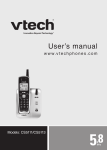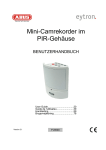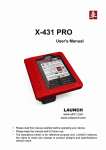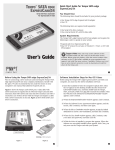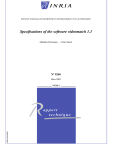Download Asus CS5110 User manual
Transcript
ASUS Desktop PC CS5110/CS5111 User Manual E3442 First Edition V1 October 2007 Copyright © 2007 ASUSTeK COMPUTER INC. All Rights Reserved. No part of this manual, including the products and software described in it, may be reproduced, transmitted, transcribed, stored in a retrieval system, or translated into any language in any form or by any means, except documentation kept by the purchaser for backup purposes, without the express written permission of ASUSTeK COMPUTER, INC. (“ASUS”). Products and corporate names mentioned in this manual may or may not be registered trademarks or copyrights of their respective companies, and are used for identification purposes only. All trademarks are the property of their respective owners. Every effort has been made to ensure that the contents of this manual are correct and up to date. However, the manufacturer makes no guarantee regarding the accuracy of its contents, and reserves the right to make changes without prior notice. Contents Contents..................................................................................................3 Notices.....................................................................................................4 Safety information...............................................................................6 Notes for this manual.........................................................................7 Welcome.................................................................. 8 Package contents.................................................................................8 Knowing your Desktop PC..................................... 9 Front / Rear panel features...............................................................9 Setting up your Desktop PC................................. 12 Connecting devices.......................................................................... 12 Connecting the AC power adapter............................................. 13 Pressing the power button to turn on the system................ 13 Using your Desktop PC......................................... 14 Using the optical drive.................................................................... 14 Inserting a disc............................................................................. 14 Ejecting a disc.............................................................................. 14 Configuring audio setup................................................................ 15 Speaker configurations............................................................. 15 Connecting to speakers............................................................ 16 Configuring audio output settings............................................. 17 Using the Media Center remote (optional).............................. 18 Wireless network connection (optional).................................. 20 Bluetooth connection (optional)................................................. 21 Recovering your system....................................... 23 Using the recovery DVD................................................................. 23 Troubleshooting................................................... 25 ASUS Desktop PC Notices Federal Communications Commission Statement This device complies with Part 15 of the FCC Rules. Operation is subject to the following two conditions: • This device may not cause harmful interference, and • This device must accept any interference received including interference that may cause undesired operation. This equipment has been tested and found to comply with the limits for a Class B digital device, pursuant to Part 15 of the FCC Rules. These limits are designed to provide reasonable protection against harmful interference in a residential installation. This equipment generates, uses and can radiate radio frequency energy and, if not installed and used in accordance with manufacturer’s instructions, may cause harmful interference to radio communications. However, there is no guarantee that interference will not occur in a particular installation. If this equipment does cause harmful interference to radio or television reception, which can be determined by turning the equipment off and on, the user is encouraged to try to correct the interference by one or more of the following measures: • Reorient or relocate the receiving antenna. • Increase the separation between the equipment and receiver. • Connect the equipment to an outlet on a circuit different from that to which the receiver is connected. • Consult the dealer or an experienced radio/TV technician for help. The use of shielded cables for connection of the monitor to the graphics card is required to assure compliance with FCC regulations. Changes or modifications to this unit not expressly approved by the party responsible for compliance could void the user’s authority to operate this equipment. ASUS Desktop PC Canadian Department of Communications Statement This digital apparatus does not exceed the Class B limits for radio noise emissions from digital apparatus set out in the Radio Interference Regulations of the Canadian Department of Communications. This class B digital apparatus complies with Canadian ICES-003. Macrovision Corporation Product Notice This product incorporates copyright protection technology that is protected by method claims of certain U.S. patents and other intellectual property rights owned by Macrovision Corporation and other rights owners. Use of this copyright protection technology must be authorized by Macrovision Corporation, and is intended for home and other limited viewing uses only unless otherwise authorized by Macrovision Corporation. Reverse engineering or disassembly is prohibited. ASUS Desktop PC Safety information Your ASUS Desktop PC is designed and tested to meet the latest standards of safety for information technology equipment. However, to ensure your safety, it is important that you read the following safety instructions. Setting up your system • Read and follow all instructions in the documentation before you operate your system. • Do not use this product near water or a heated source such as a radiator. • Set up the system on a stable surface. • Openings on the chassis are for ventilation. Do not block or cover these openings. Make sure you leave plenty of space around the system for ventilation. Never insert objects of any kind into the ventilation openings. • Use this product in environments with ambient temperatures between 0˚C and 40˚C. • If you use an extension cord, make sure that the total ampere rating of the devices plugged into the extension cord does not exceed its ampere rating. Care during use • Do not walk on the power cord or allow anything to rest on it. • Do not spill water or any other liquids on your system. • When the system is turned off, a small amount of electrical current still flows. Always unplug all power, modem, and network cables from the power outlets before cleaning the system. • If you encounter the following technical problems with the product, unplug the power cord and contact a qualified service technician or your retailer. • The power cord or plug is damaged. • Liquid has been spilled into the system. ASUS Desktop PC • • • The system does not function properly even if you follow the operating instructions. The system was dropped or the cabinet is damaged. The system performance changes. LASER PRODUCT WARNING CLASS 1 LASER PRODUCT NO DISASSEMBLY The warranty does not apply to the products that have been disassembled by users This symbol of the crossed out wheeled bin indicates that the product (electrical, electronic equipment, and mercurycontaining button cell battery) should not be placed in municipal waste. Check local regulations for disposal of electronic products. Notes for this manual To make sure that you perform certain tasks properly, take note of the following symbols used throughout this manual. WARNING: Vital information that you MUST follow to prevent injury to yourself. IMPORTANT: Instructions that you MUST follow to complete a task. TIP: Tips and useful information that help you complete a task. NOTE: Additional information for special situations. ASUS Desktop PC Welcome Congratulations on your purchase of the ASUS Desktop PC. The package contents of your new Desktop PC are listed below but may vary with models. ASUS reserves the right to replace components or accessories to provide optimum serviceability. Contact your retailer if any item is damaged or missing. Package contents • • • • • • • • • • • ASUS Desktop PC x1 Keyboard x1 Mouse x1 AC power adapter x1 Power cord x1 Support DVD x1 Recovery DVD x1 Installation Guide x1 Anti-slip pad x1 Warranty card x1 Remote control (optional) x1 Visit the ASUS website at http://support.asus.com for any updates. ASUS Desktop PC Knowing your Desktop PC Front / Rear panel features Front (Close) Front (Open) Rear 9 1 4 5 6 10 7 8* 11 2 3 12* *����������������������������������������������������������� The gray areas contain front/rear panel ports. These ports and their locations may vary, depending on the model of your system. No. Button/LED Description 1. Slot-in optical drive 2. Optical drive eject button 3. Slide the front panel cover open 4. Wireless network/Bluetooth LED 5. Hard disk drive LED 6. Power button/LED 7. Front panel cover continued on the next page ASUS Desktop PC No. 8. Slot/Port Description MS/MS Pro card slot CF card slot SD/MMC card slot MS/MS Pro/SD/ MMC card slot 4-pin IEEE 1394a port S/PDIF In port USB 2.0 ports 9. 10. 11. Headphone jack Microphone jack Air vents Power input Kensington® Lock port VGA port HDMI port DVI-D port 12. LAN (RJ-45) port USB 2.0 ports Functions as a card reader for various types of memory cards. Connects to an IEEE 1394 device such as a digital camrecorder. Connects to digital audio source. Connect to USB devices such as a mouse, keyboard, or camera. Plug a stereo or headphones into this jack. Plug a microphone into this jack. Allows ventilation. Supplies power. Allows the PC to be secured to a fixed object using Kensington® compatible security products. Connects to a TV or monitor with different video output. Plug a network cable into this port. Connect to USB devices such as a mouse, keyboard, or camera. continued on the next page 10 ASUS Desktop PC 6-pin IEEE 1394a port Optical S/PDIF Out port Coaxial S/PDIF Out port 12. 5.1(6)-channel audio ports 7.1(8)-channel audio ports Connects to an IEEE 1394 device such as a digital camrecorder. Connects to an amplifier for digital audio output. Connect to a 5.1(6) or 7.1(8)-channel speaker system. Refer to page 15 and 16 for setup details. ASUS Desktop PC 11 Setting up your Desktop PC Connecting devices Do not block or cover these openings. Display Network hub/ switch Mouse Keyboard 12 ASUS Desktop PC 7.1(8)-channel speaker system Connecting the AC power adapter 3 2 1 Pressing the power button to turn on the system ASUS Desktop PC 13 Using your Desktop PC Using the optical drive Inserting a disc 1. Place the disc to the slot-in optical drive with the label side facing your left. 2. Slide the disc into the drive. Label side Data side Ejecting a disc 1. While the system power is on, press the eject button. 2. Remove the disc from the opening. 14 ASUS Desktop PC Configuring audio setup ASUS Desktop PC comes with six audio jacks on the rear panel that support up to 7.1 channel audio configurations. Speaker configurations You may set up your Desktop PC with the following speaker configurations: Audio jack Speaker layout Headphones 2 (stereo) 2.1 4.1 5.1(6) 7.1(8) Left speaker, right speaker. Left speaker, right speaker, and a subwoofer. Two front speakers, two rear speakers, and a subwoofer. Two front speakers, two rear speakers, a center speaker, and a subwoofer. Two front speakers, two rear speakers, two side speakers, a center speaker, and a subwoofer. Speaker types A stereo speaker set is a left-right, two channel speaker system. A multi-channel audio speaker has a left-right front and leftright rear channel, and it may include a subwoofer and a center speaker. Side speakers are included in a more advanced system. A subwoofer provides enhanced bass sounds. “.1” indicates a subwoofer. For instance, 7.1 channels refers to an eight-speaker mode and uses two front speakers (left-right), two rear speakers (left-right), two side speakers (left-right), a center speaker, and a subwoofer. ASUS Desktop PC 15 Connecting to speakers Refer to the table below for the audio jacks on the rear panel and their functions. Audio jack Description Line In (light blue) connects to an analog audio source like a CD/DVD player. Line Out (lime) connects to a headset or front speakers. Microphone (pink) connects to a microphone. Center/Subwoofer (orange) connects to a center speaker or a subwoofer. Rear Out (black) connects to rear speakers. Side Out (gray) connects to side speakers. 16 ASUS Desktop PC Configuring audio output settings After connecting a speaker system to your Desktop PC, follow the steps below to configure audio output: 1. Right-click the volume icon on the Windows® Vista™ taskbar and select Playback Devices. 2. Under the Playback window, select an audio device and click Set Default. 3. Click OK and you will see a check beside the device you select. 4. Relaunch your media player, e.g. Windows® Media Player or Power DVD, and the device you set will serve as the default audio output device. • • • You must relaunch your media player to effect the audio output device settings. If you want to set up a recording device, select Recording Devices in Step 1 and do what resembles Step 2 and 3. If you use an HDMI display with S/PDIF audio output, set Realtek Digital Output as the default in Step 2. ASUS Desktop PC 17 Using the Media Center remote (optional) Use the remote to launch the Media Center program to play media files such as music and movies. You can also install an external TV box to watch TV and record TV programs. Refer to the table below to familiarize yourself with the functions of the remote control buttons. 1 2 3 22 21 20 4 19 5 18 6 7 17 8 16 9 10 15 11 12 14 13 No. Button 1. Power 2. 3. Pause Stop 18 ASUS Desktop PC Description Press to turn on/off the power of the screen and the speakers. Press to pause a playback. Press to stop playing a media file. 4. 5. Fast-foward Next track Press to fast-forward a media file. Press to go to the next track. Press to display program information 6. Information under Media Center or other menu options. Four-way Press to scroll through on-screen 7. navigation keys display menus. Windows® Media Press to launch the Media Center 8. Center program. 9. Channel up/down Press to change TV channels.* 10. Mute Press to disable audio output. Press to display a list of your recorded 11. Recorded TV TV programs.* EPG (Electronic Press to display the electronic 12. Program Guide) program guide screen.* 13. Live TV button Press to watch live TV programs. * Toggles between numerical and 14. Shift alphabetical input. 15. Teletext buttons Available on European models only. Press to increase/decrease the 16 Volume up/down volume. 17. OK Press to confirm an action. 18. Return Press to return to the previous page. 19. Previous track Press to go back to the previous track. 20. Rewind Press to rewind a media file. 21. Play Press to play a media file 22 Record Press to start recording TV. *The system does not come with built-in TV tuner. To use the TV function, purchase an external TV box first. ASUS Desktop PC 19 Wireless network connection (optional) To connect to a wireless network, follow the instructions below. 1. On the Windows® taskbar, right-click on the network icon and select Connect to a network. 2. Select the wireless network you want to connect to from the list. Select Show Wireless if there are many networks in your area. 3. Enter the security key or passphrase if necessary. This screen does not appear if no security key is needed. 20 ASUS Desktop PC 4. When a connection is established, the network status shows Connected. Bluetooth connection (optional) To connect to Bluetooth-enabled devices, follow the instructions below. 1. Double-click the Bluetooth icon on the Windows® taskbar to start the connection wizard. 2. Select the Bluetooth device you want to connect to from the list and click Next to continue. If you do not see the device you want to connect to on the list, click Refresh to search for it. ASUS Desktop PC 21 3. Enter the password for the device if authentication is required. 4. When the setup is completed, click Next to continue. 5. The device you are connecting to is shown. 6. Click the New Connection button and follow steps 1 to 5 to add more Bluetooth devices. 22 ASUS Desktop PC Recovering your system Using the recovery DVD The recovery DVD includes an image of the operating system installed on your system at the factory. The recovery DVD, working with the support DVD, provides a comprehensive recovery solution that quickly restores your system to its original working state, provided that your hard disk drive is in good working order. Before using the recovery DVD, copy your data files (such as Outlook PST files) to a USB device or to a network drive and make note of any customized configuration settings (such as network settings). 1. Turn on your ASUS Desktop PC and the ASUS logo appears. Press F8 to enter the Please select boot device menu. 2. Insert the recovery DVD into the optical drive and select the optical drive (“CDROM:XXX”) as the boot device. Press Enter and then press any key to continue. 3. The Windows Boot Manager window appears. Select Windows Setup [EMS Enabled] and press Enter. Wait when the Windows is loading files message appears. 4. Select where to install a new system. Options are: Recover system to a partition This option will delete only the partition you select from below, allowing you to keep other partitions, and create a new system partition as drive “C.” Select a partition and click NEXT. Recover system to entire HD This option will delete all partitions from your hard disk drive and create a new system partition as drive “C.” Select and click Yes. 5. Follow the on-screen instructions to complete the recovery process. You will lose all your data during the system recovery. Make sure that you make a backup of it before recovering the system. ASUS Desktop PC 23 6. After the system recovery is completed, you will be asked to insert the support DVD into the optical drive. Click OK and the system reboots. 7. After the system reboots, Windows® Vista™ will begin system configurations. Follow the on-screen instructions to complete the process, and then restart the computer. This recovery DVD is for ASUS Desktop PC only. DO NOT use it on other computers. Visit the ASUS website www.asus.com for any updates. 24 ASUS Desktop PC Troubleshooting Read the following Q&As for troubleshooting guide. If these do not give you answers, you may contact us directly at the contact information provided in the support DVD. What can I do if my Desktop PC cannot be powered on? Check if the power LED on the front panel lights up. It does not light up if no power is supplied to the system. • Find out if the power cord is plugged in. • When you use an extension cord or a voltage regulator, ensure that you have plugged it into the wall socket and switched it on. What can I do if my Desktop PC cannot enter the operating system? • Make sure that you use memory modules that the system supports and that you install them properly on the sockets. • Check if your peripheral devices are compatible with the system. Some USB storage devices, for example, are with different disk drive structure and enter sleep mode easily. If the above steps do not solve the problem, contact your retailer or perform system recovery using the supplied recovery DVD. You will lose all your data during the system recovery. Make sure that you make a backup of it before recovering the system. Why is it that I cannot hear anything from my speakers/ headphones? Check the volume icon on the Windows® taskbar to see if it is set to mute . If so, double-click this icon to display the volume bar, and then click the mute icon under the bar to cancel the muted mode . ASUS Desktop PC 25 Why is it that a CD/DVD cannot be read from or written to? • Make sure that you use a disc compatible with the optical drive. • Check if you insert the disc properly or if there is any scratch on the disc. • Find out if the disc is with write protection. 26 ASUS Desktop PC



























